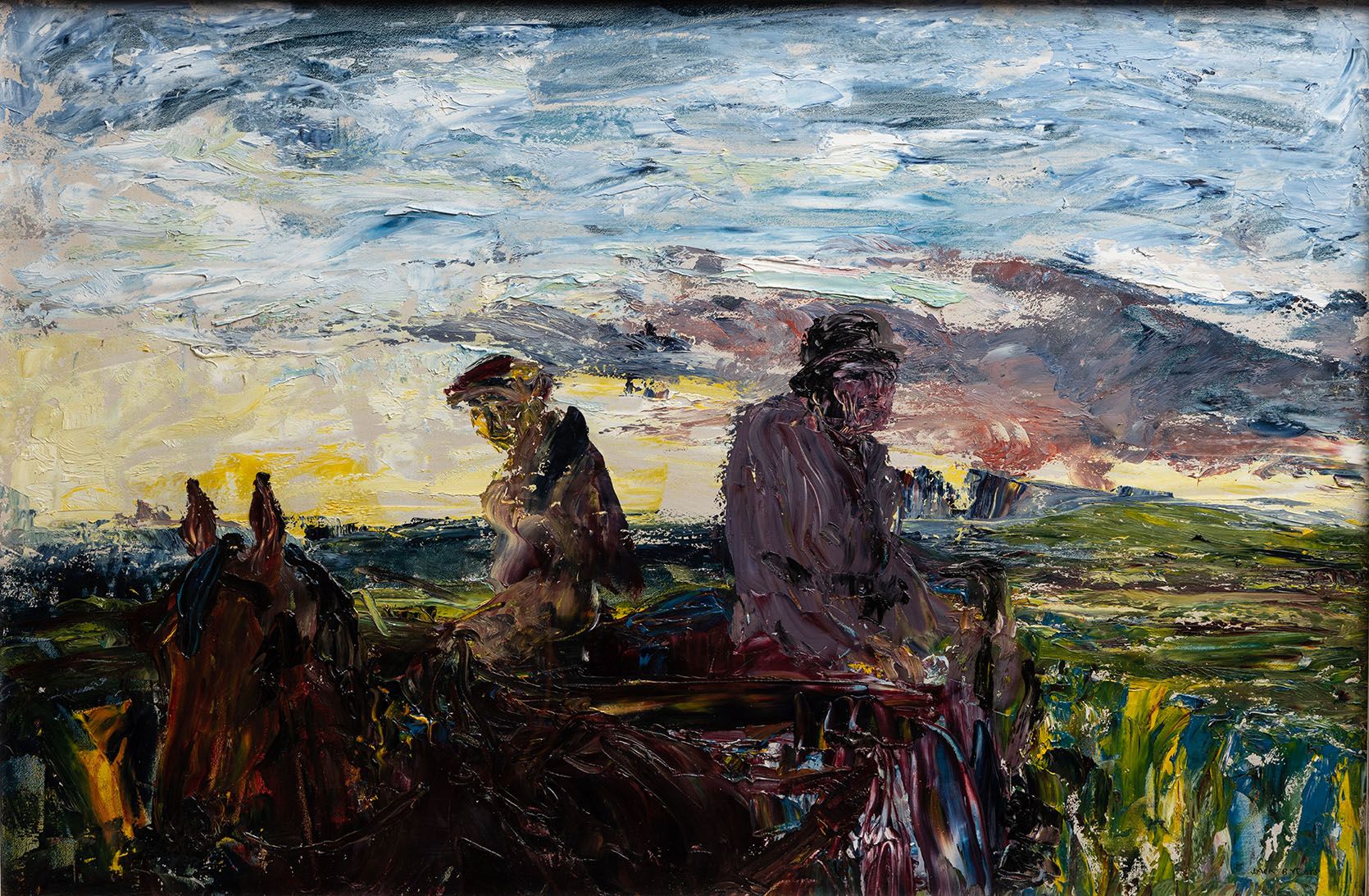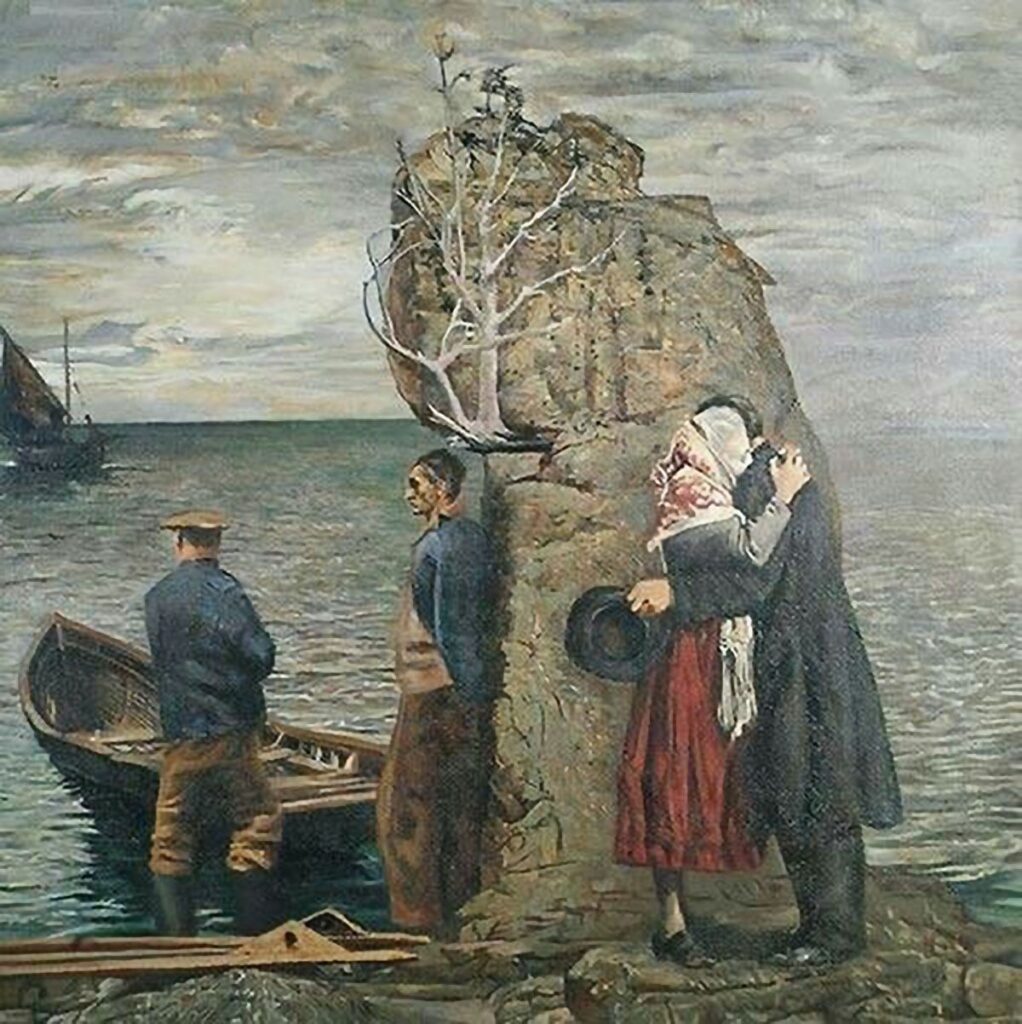
Jack Butler Yeats (1871–1957)
Farewell to Mayo, 1929
Oil on paper
McMullen Museum of Art, Boston College, Carolyn A. and Peter S. Lynch Collection, 2021.23

Kevin Lotery
Assistant Professor, Art History

Though known primarily as a painter, Jack B. Yeats devoted large portions of his career to writing and illustrating. He got his start as a jobbing illustrator and designer before taking up painting around the turn of the century, followed by periods given over to writing plays. The resulting oeuvre of paintings, works on paper, and texts, extending past the end of the Second World War, speaks to an ethos of disciplinary and generational cross-fertilization, nourished at least in part by a family of artists and writers, which included his father, painter John Butler Yeats and his elder siblings: embroiderer Susan Mary Yeats, publisher Elizabeth Corbet Yeats, and poet William Butler Yeats. A literary, even theatrical, sensibility underlies even Yeats’s most painterly projects, such as Farewell to Mayo, which stages, self-consciously, the drama of a passing moment for us, their spectators, granting access to a scene of dislocation and loss. Here two figures, a traveler and a coach man, look back, Orpheus-like, at the spectator, who now stands in ambiguous relation to the home to which they are forever in the process of bidding “farewell.” Are we remaining in County Mayo, whose famous cliffs we see crudely depicted on the horizon? Or are we merely passersby, witnesses to a process of leaving? Like Yeats’s two figures, it seems that we too are dislocated by the painting, such that the act of looking is endowed with something of the disorientation of leaving the comforts of home.
The Irish writer Samuel Beckett (1906–89), a key observer of Yeats’s work, may have had such scenes in mind when he wrote that the painter “[sends] us back to the darkest part of the spirit that created it,” refusing romantic clichés of home or of “heritage, national or otherwise.”1 While the work seems to call up the pathos of loss and leaving, as if to transport spectators from the historical specificities of Irish country life to some mythical, allegorical domain outside of time, it does so only to expose any such attempt as an illusory performance, staged in paint.
It may only be a coincidence that the painting was once owned by Vivien Leigh, the Oscar-winning actress who played Scarlett O’Hara in Gone with the Wind (1939), that most repressive, romanticizing Technicolor spectacle of the institutionalized horrors of the American plantation system. Opposed to such nativist nostalgia, Yeats’s picture presents figures forever in the act of saying “farewell” to the viewer across the unbridgeable divide of the picture frame. They are, in other words, Beckettian wanderers to the core, trapped forever by the stage or by the effects of the frame. Loss, trauma, erasure: rather than mere narrative or allegorical content, these forces are, as in Beckett’s plays, the structuring conditions of Yeats’s work. In scenes like this, then, we might locate a peculiar critique of essentializing, nativist understandings of home, showing them to be mythic scenes animated not by pathos but by mere matter, pushed around on a surface.
1. Samuel Beckett, “Homage to Jack B. Yeats” (April 1954), in Jack B. Yeats: A Celtic Visionary, ed. Howard Smith and Stephen Snoddy (Manchester: City Art Galleries, 1996), n.p.
Robert Savage
Professor, History & Irish Studies

In spite of Ireland’s gaining independence, in the early decades of the twentieth century emigration continued to haunt the country. The west of the island was especially impacted by a relentless “flight from the land” as many young women and men felt compelled to leave home in search of work and a better life. Yeats captures the emotion of the emigration experience in Farewell to Mayo, a painting that mirrors Seán Keating’s iconic Economic Pressure from two decades later (see image). Keating’s realist painting captures the emotional toll of emigration on Irish society by depicting a man embracing his mother before leaving his home in the Aran Islands. Unlike Keating, Yeats paints in the expressionist style. There is no escaping the raw emotions in the figures that confront the viewer. The faces and body language of the men with shoulders slumped and faces drawn suggests resignation and despair. Yeats’s painting speaks to the economic and social challenges that confronted independent Ireland through much of the twentieth century.

Nancy Netzer
Inaugural Robert L. and Judith T. Winston Director, McMullen Museum and Professor, Art History

Jack Yeats retained this large painting in his personal collection until 1942 when he lent it to the National Gallery in London for an exhibition curated by the Gallery’s director, Sir Kenneth Clark. During the run of the exhibition, Clark invited the actress Vivien Leigh, whom he often visited in her dressing room at the nearby Haymarket Theatre, for a private tour. Seeing Yeats’s painting of an emigrant and driver in a one-horse cart leaving Mayo for America with a reddened sky in the background reminded Leigh of her escape, in a similar horse drawn cart, from a burning Atlanta when she played the shrewd and calculating Scarlett O’Hara in the 1939 film Gone with the Wind, for which she won an Academy Award. Leigh had vacationed in Ireland as a child; her mother had Irish roots and her father was buried in Mayo. The painting resonated so deeply with Leigh that her husband, the famous British actor and director Sir Laurence Olivier, bought it for her after the exhibition from Yeats’s dealer, Victor Waddington. The painting remained in Leigh’s estate until it was sold to Carolyn and Peter Lynch at Sotheby’s in London in 1996.
